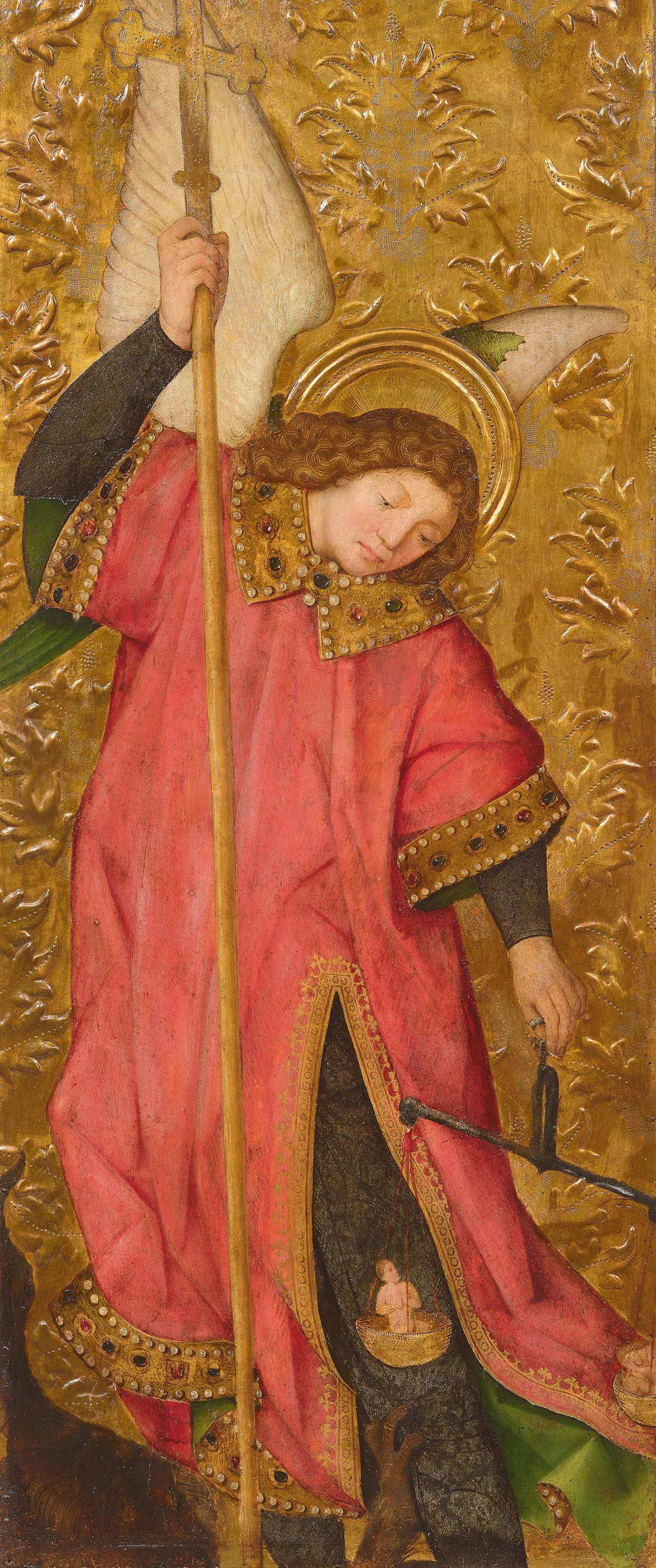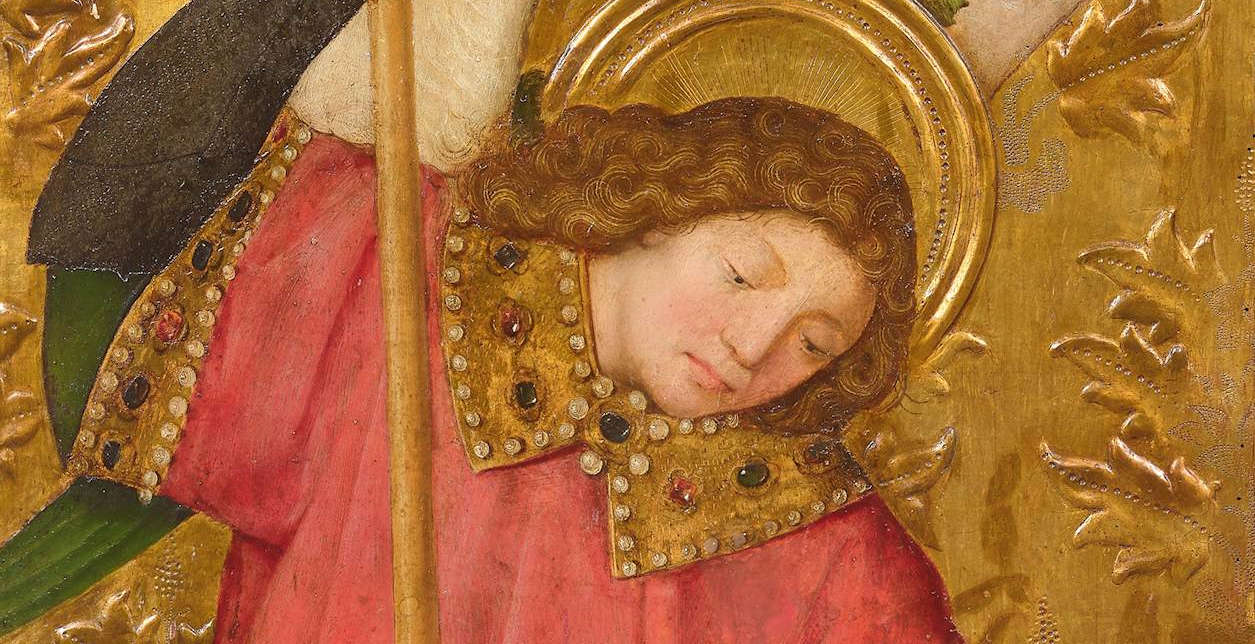An important page in the history of 15th-century Piedmontese art has been enriched with a new chapter after the auction sale of Antoine de Lonhy’sArchangel Michael, a gold ground panel of extraordinary refinement recently resurfaced from a Swiss private collection and sold by Koller. The work, which had been offered with a starting base of just 30,000 Swiss francs during cataloguing, sparked a tight competition among several buyers and finally won for the sum of 170,000 francs, to which auction fees must be added, for a total of about 230,000 euros. The winning bidder, according to the newspaperLaStampa, was two dealers from Turin, Filippo Benappi and Marco Voena, who let it be known that they conducted a joint operation avowedly aimed at bringing the work back to its homeland.
The panel, measuring 103.8 by 44.4 centimeters, depicts the archangel Michael in an elegant pose that well testifies to the style of the Burgundian painter Antoine de Lonhy, who was active in several European regions in the mid- to late 15th century. The delicate rendering of the hair, the collected and devout expression of the face, and the careful use of tempera and gold ground confirm the qualities of an artist who knew how to blend influences from Burgundy, Catalonia, Savoy, and Piedmont, and whom in recent decades critics have gradually rediscovered and enhanced.

The work constitutes a key piece of a dismembered altarpiece originally commissioned by Dominican friars. The five-part complex had as its centerpiece a central panel with the Nativity, now in the Museum Mayer van den Bergh in Antwerp. On the left side were the figure of St. Dominic, now in the Galleria Sabauda in Turin, and the very Archangel Michael now being auctioned in Zurich. On the right side were two other panels: saint John the Baptist with the patron, still in a private Swiss collection, and Saint Vincent Ferrer, now in the Musée de Cluny in Paris. Completing the ensemble was probably a predella, the fate of which is unknown.
The provenance of the work is only precisely traced from the nineteenth century onward. The panel was in fact part of Francesco Molinari’s collection in Milan, where it was attributed to Macrino d’Alba. Unsold at the Giulio Sambon auction in 1885, it passed to his son Giuseppe and later to Ettore Molinari, who took it to Paris. There, in 1890, it was auctioned at the Hôtel Drouot, before entering a private Swiss collection where it remained for over a century. Bibliographic sources attest to numerous references to the work and the altarpiece of which it was a part, from early mentions in nineteenth-century catalogs to reconstructions by scholars such as Charles Sterling, Giovanni Romano, François Avril and more recently Frédéric Elsig and Serena d’Italia, to the catalog of Antoine de Lonhy’s exhibition The European Renaissance held in Turin in 2021.
The attribution to the Burgundian painter, also known in the past as the “Master of the Trinity of Turin,” has been confirmed by the most authoritative studies. The debate on the origin of the altarpiece remains open: according to Giovanni Romano it may have been commissioned for the church of San Domenico in Turin, while Serena d’Italia has suggested a connection with the same church but in Chieri, with the involvement of the Solaro family. In both cases the work is deeply rooted in the Piedmontese context of the 15th century, testifying to the European influences that characterized artistic production in the region at that time.
For a work of this kind, the figure achieved represents an acknowledgement of its historical and artistic value, as well as an encouragement to research and recovery of evidence still hidden in private collections.
Antoine de Lonhy, a painter, manuscript illustrator and stained-glass creator, was a cosmopolitan figure who brought to Piedmont an original synthesis of the artistic cultures he encountered during his travels. His activity, documented from 1446 to the years around 1490, includes works ranging from Burgundian language to Catalan sensibility to the assimilation of Italian Renaissance models. Its critical rediscovery, initiated in the 20th century by scholars such as Romano and Avril, has gradually restored the artist to a leading role in the European Renaissance.
TheArchangel Michael beaten in Zurich thus enriches knowledge of Piedmontese painting. The acquisition thus takes on a significance that goes beyond mere economic data: in fact, it reaffirms the importance of the preservation and enhancement of works of art as instruments of historical and identity knowledge, and underscores how the international market can play a decisive role in the fate of artistic testimonies. In the case of Antoine de Lonhy, the rediscovery and return of theArchangel Michael offer a rare opportunity to delve into the complexity of his visual language and to better understand the artistic dynamics of 15th-century Piedmont, a crossroads of European cultural influences.
 |
| Antoine de Lonhy's Archangel Michael returns to Piedmont thanks to two Turin merchants |
Warning: the translation into English of the original Italian article was created using automatic tools. We undertake to review all articles, but we do not guarantee the total absence of inaccuracies in the translation due to the program. You can find the original by clicking on the ITA button. If you find any mistake,please contact us.